|
On The Roundabout With Deep Purple
by
Kieron Tyler

Deep
Purple were on top of the world in June 1973. Smoke On The Water was
climbing the US charts. They were news wherever they went. Dates in
Germany were regularly accompanied by rioting audiences, with police
and water cannons on stand by. A two-month American tour had just been
completed and the band were in Japan topping off an incredibly successful
three years. Yet within the band relations were plummeting to an all-time
low. "The idea of going to Japan was presented to us at a band
meeting,' remembers Purple's bass player, Roger Glover. 'Ritchie Blackmore
said 'I'm not going. I didn't say you couldn't go to Japan, I just said
I'm not going.' Ritchie didn't care what anyone else thought, he had
his own path."
The
pressure had already begun taking its toll.
"We were in San Antonio, Texas in 1972, being called down to lobby
to go to a gig," recalls Jon Lord. "Ritchie was coming out
his room. He walked past me without looking at me, his shoulders were
shaking, I thought he was laughing. I walked round in front of him and
he was crying his eyes out. He said "I can't do it, I want go home.'
It was exhaustion."
That
June became Glover and singer Ian Gillan's final month with the band.
Frustrated with Blackmore and constant clashes with the band's management,
Gillan had handed in his resignation letter the previous October. Glover
joined him in leaving because he realised that Blackmore wanted him
out. Not that Blackmore had bothered to tell him. "Ritchie only
said one thing to me, at the last gig in Osaka," recalls Glover.
"I passed him on the stairs leading to the stage. There was no
one else around. He said, 'by the way, it's nothing personal, it's just
business.'"
It
was nothing new. Since the beginning, Deep Purple had ruthlessly hired
and fired in their pursuit of the ultimate line up. Whenever it seemed
as though the band had settled down, someone else was pushed over the
edge, becoming yet-another ex-member of Deep Purple. The pattern had
been set right from the start, before the band was called Deep Purple,
from when it was Roundabout, an outgrowth of a still-born vehicle for
ex-Searchers drummer Chris Curtis. Even in its prehistory, the story
of Deep Purple is of business over friendship, at whatever the cost
to band-members livelihoods. Roundabout was apt name, for that's what
most of the musicians were on.

The
hard-rock Deep Purple of In Rock, Fireball, Child In Time and Smoke
On The Water was light-years from what the band might have been. What
became Deep Purple arose from a series of chance events that had been
seized upon by Tony Edwards, a budding entrepreneur with his eyes on
the golden prize of Swinging '60s pop success.
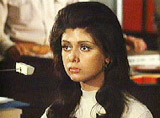 In
1966 Edwards was working in London's West End for Alice Edwards Holdings
Ltd, his family's clothing company. He'd turned his hand to the pop
scene after coming across a singer-turned-model named Ayshea (later
familiar to pop fans from compering the '70s tea-time pop show Lift
Off). In
1966 Edwards was working in London's West End for Alice Edwards Holdings
Ltd, his family's clothing company. He'd turned his hand to the pop
scene after coming across a singer-turned-model named Ayshea (later
familiar to pop fans from compering the '70s tea-time pop show Lift
Off).
"I was not particularly happy in the rag trade,' recalls Edwards.
'I was trying to get Ayshea onto Ready Steady Go and became friendly
with Vicki Wickham [RSG's editor/producer]. She came to dinner one evening
with Chris Curtis in tow. I was quite in awe of him. In my eyes Chris
was a John Lennon character with great flights of imagination and fancy."
After
the brief encounter with Curtis, Edwards knuckled down to keeping the
fashionable customer satisfied. But,
"a year later, from out of the blue, Chris rang me from Liverpool.
He said I'd like you to be my manager. I'll teach you everything. Brian
Epstein's dead, you can be the next Brian Epstein.' That hooked me."
At
the time Curtis was planning his return to pop, Jon Lord was also pondering
his future. He had recently left jazzy west London R&B outfit The
Artwoods, a band formed around Art Wood, brother of future-Face and
Rolling Stone, Ron. Despite being a live draw and having released an
album in 1966, The Artwoods were going nowhere. An attention-seeking
name change to St Valentine's Massacre, matched by a new gangster-suited
image, hadn't clicked with record buyers - except in Denmark. "I'd
pushed the boundaries of The Artwoods as far as I could go," says
Lord. "I was sticking Bach and Tchaikovsky into my organ solos
and I think it rather frightened them."
Lord was making ends meet playing organ in the touring incarnation of
The Flowerpot Men, who hit big in summer 1967 the flower-power cash-in
Let's Go To San Francisco. As the record was a studio creation, a band
of jobbing musicians were cobbled together to promote the hit.
While
Lord was marking time with the Flowerpot Men, Chris Curtis had decided
how his new band was going to proceed. "He said, 'I've got this
band,'" remembers Edwards."I said, 'where is it, can I see
them?' He tapped his head, 'that's where they are.'"
 Lord
first encountered Curtis at a party hosted by the ubiquitous Vicki Wickham: Lord
first encountered Curtis at a party hosted by the ubiquitous Vicki Wickham:
"He said, 'I've got this concept.' As it was the summer of ¹67,
concepts sounded wonderful. It was to be three people as the core. The
third person was a bass player, who I never met. I don't know if he
existed. We would engage other people as we felt like it. They would
jump on and off the roundabout. But I left that party in a new band,
Roundabout."
"A
few weeks later Curtis was living in my flat,"continues Lord. "I
don't know how it happened. There were limousines picking him up, I
was tremendously impressed. He told me that he had met a businessman
who was really interested in putting up 'the bread, man'."
That businessman was Tony Edwards. "The invoice from the hire company
for the Daimler would end up on my desk the next day. I couldn't really
cope with that, but I had a great rapport with Jon Lord, here was somebody
sensible, somebody I could communicate with on my level, my very square
level."
It
was soon clear that Curtis was on a very different level to everyone
else around him, not least his flatmate Jon Lord: "I came back
from being up north for a few days with The Flowerpot Men, and my entire
flat was covered in silver paper. The tables, chairs, the toilet, the
toilet seat. The lightbulbs, which blew every time you turned them on.
Windows, everything. Chris came out of the loo and said, 'hey man, what
do you think? New
concept.' I knew he'd lost it. I was quite naïve, I knew what acid
was, but I didn't know what it did. A few days later, he suddenly wasn't
there."
"I saw the remains of the silver foil," confirms Edwards.
"Chris thought it would give the flat more atmosphere."
Before
bailing out, Curtis told Lord that he had a guitarist in mind for Roundabout.
"He told me he had this fantastic guitarist who lived in Hamburg.
I thought he was German, but Curtis said 'no, he's English, but he loves
it over there. He wouldn't come back for anyone but me.'"

Ritchie
Blackmore was already a veteran of both the Joe Meek-produced instrumental
band The Outlaws and Screaming Lord Sutch and the Savages. His wild
solos were the most striking thing about most of Heinz's Meek-produced
singles. Blackmore had gone to Germany in 1966 with Neil Christian and
the Crusaders, and liked it so much that he stayed there with a band
called The Three Musketeers. When they split he tried to form a new
combo, Mandrake Root.
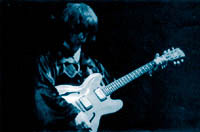 Unbeknownst
to Lord, Edwards had already sneaked Blackmore into the UK to check
out a Flowerpot Men gig. Edwards recalls Blackmore as "dark, saturnine,
brooding, with a great charisma. I can't remember him saying much. He
looked around. Searchingly. But Chris disappeared back to Liverpool.
Blackmore went back to Germany. The whole concept fell into disarray."
That really
should have been it for Roundabout. Chris Curtis may have vanished and
Ritchie Blackmore had returned to Germany, but Tony Edwards had been
bitten by the pop bug. Unbeknownst
to Lord, Edwards had already sneaked Blackmore into the UK to check
out a Flowerpot Men gig. Edwards recalls Blackmore as "dark, saturnine,
brooding, with a great charisma. I can't remember him saying much. He
looked around. Searchingly. But Chris disappeared back to Liverpool.
Blackmore went back to Germany. The whole concept fell into disarray."
That really
should have been it for Roundabout. Chris Curtis may have vanished and
Ritchie Blackmore had returned to Germany, but Tony Edwards had been
bitten by the pop bug.
"I was running for a taxi to catch a plane to Munich for The Flowerpot
Men," recalls Lord. "I heard the phone ringing. It rarely
rang, and when it did it was usually work. It was Tony Edwards saying
'I don't know what's happened to Chris Curtis, when you get back we
must talk.' It was a key moment in my life."
Once
again, Tony Edwards got his cheque book out and for a second time brought
Blackmore back from Germany, this time for keeps. It was December 1967.
"Ritchie came to the flat, which I de-foiled," recalls Lord.
"He appeared at my door in a snowstorm, carrying an acoustic guitar.
That night we came up with two of the songs that went on the first [Deep
Purple] album, And The Address and Mandrake Root. It was wonderful evening.
Right away I felt that he wouldn't suffer fools gladly, but it felt
right. Ritchie seemed dark, he always seemed dark."
 Edwards
decided that he was in all the way and began committing himself to the
nascent band, still named Roundabout. "I financed the concept.
All my personal shareholdings in the family business were there as collateral
for Edwards
decided that he was in all the way and began committing himself to the
nascent band, still named Roundabout. "I financed the concept.
All my personal shareholdings in the family business were there as collateral
for
financing equipment, subsistence, rents."
With management and backing in place, Lord and Blackmore began filling
out the line up. Blackmore was convinced Bobby Woodman was the right
drummer. Woodman had been in France since 1962, when had moved there
as one of Vince Taylor's Playboys. Having been one of Marty Wilde's
Wildcats he was a legend in the pre-Beatles British rock scene.
"Ritchie had seen Woodman with Johnny Hallyday," recalls Lord.
"He was most taken with the fact that he used two bass drums."
Woodman
was duly summoned from France and the search for more band members continued.
Next up was bass player Dave Curtiss, who had led early '60s beat outfit
Dave Curtiss and the Tremors and was also currently resident in
France. "Bobby and I were working in Paris, we used to play together
with Vince [Taylor]," remembers Curtiss. "Bobby said it might
be worth coming over to check this out. It was a question of getting
guys together who had a bit of a reputation, to get a kind of supergroup
together. I knew of Ritchie. At the time there weren't that many shit-hot
guitarists going around. There were a handful, Big Jim Sullivan, Clapton.."
Curtiss,
however, had limited time to find out what - if anything - was happening
with the new band:
"I was playing bass for [French star] Michel Polnareff and I couldn't
hang around indefinitely. I came over for a week and sat down with Ritchie
a couple of evenings going over ideas. Jon Lord was just, 'hello etc.
We should get together.' There was no musical direction at all. Had
we sat down and played at any point something might have come together.
But nothing materialised so I said 'thanks guys, but I've got work to
do back in Paris."
With
Curtiss gone, Lord and Blackmore were back to looking for a bass player.
This time around the suggestion came from Lord. "Nick Simper was
the next on board because he was also in The Flowerpot Men," remembers
Lord. "He had a penchant for frilly shirts. Ritchie thought he
looked pretty cool. Ritchie was very much into the way things should
appear."
"I knew this was bubbling under," recalls Simper, then a road-hardened
veteran of Johnny Kidd's Pirates, as well as The Flowerpot Men. "I
didn't take a lot of interest until I heard Bobby Woodman was on drums.
I was a little bit in awe of Bobby because of his pedigree and desperately
wanted to be in a band with him. Jon said 'I'm getting this new thing
together, would you give this up for £25 a week?' We were earning mega
money with The Flowerpot Men but, because of Bobby Woodman, I said 'yeah,
just watch me.'"

With the line up settled at Ritchie Blackmore, Jon Lord, Nick Simper
and Bobby Woodman, all Roundabout needed was a singer. The musical direction
could come later.
"We weren't quite sure what we wanted to do," explains Simper.
"But we knew it was going to be new and different. We had the four
of us and no singer. We wanted someone young, youthful looking to front
it."
The band began rehearsing at Deeves Hall, a large farmhouse
in the south Hertfordshire commuter belt, north of London.
 "Occasionally
Tony Edwards would come down to see what he had wrought and he would
walk away looking very puzzled," says Lord. "Vanilla Fudge
were very much an influence. They'd appeared at The Speakeasy, and had
amazed me. I had a long chat with [Fudge vocalist and organist] Mark
Stein that night. I learnt a couple of tricks that I put to use." "Occasionally
Tony Edwards would come down to see what he had wrought and he would
walk away looking very puzzled," says Lord. "Vanilla Fudge
were very much an influence. They'd appeared at The Speakeasy, and had
amazed me. I had a long chat with [Fudge vocalist and organist] Mark
Stein that night. I learnt a couple of tricks that I put to use."
"I don't think I was familiar with the sort of music they were
creating," confirms Edwards. "I was rather aghast, but I believed
in an artistic integrity and felt they knew better than I did. They
did know better than I did."
"We were getting nowhere auditioning singers," says Simper.
"We had put out feelers to Terry Reid and the reply came back through
the management that he wasn't interested."
Finding a singer wasn't the only problem."It didn't seem like Bobby
Woodman was enormously interested in working," recalls Lord. "Ritchie
and I began to realise that his time keeping wasn't spot on. So we decided
we might have to get another drummer."
"What the three of us wanted to do was not what Bobby wanted to
do," says Simper. "t was very difficult, because we got on
great with him. Whatever ideas we came up with, Bobby rubbished them
all. We'd kick riffs around and Bobby would say 'that's circus music.'"
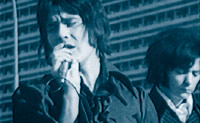 A
double-handed solution to the singer/drummer issue turned up in the
form of Rod Evans and Ian Paice, singer and drummer in a band called
The Maze. When Rod Evans arranged to audition for Roundabout, he was
asked to bring his band's drummer along. A
double-handed solution to the singer/drummer issue turned up in the
form of Rod Evans and Ian Paice, singer and drummer in a band called
The Maze. When Rod Evans arranged to audition for Roundabout, he was
asked to bring his band's drummer along.
"The Maze was going nowhere," explains Paice. "We had
played in Hamburg the year before at The Star Club and Ritchie remembered
Rod from that. He was apparently quite impressed with my drumming and
said to Rod, 'have you still got the drummer? Get him to come along.'"
It was immediately obvious that Rod Evans was a good prospect. "Rod
actually said he had an idea for the Beatles' Help, really slow,"
remembers Simper. "We thought 'this guy's got ideas'. But Bobby
Woodman wasn't interested, he just switched off.'
Although Ian Paice had been waiting in another room during Evans' audition,
he was soon called in for a try out. "Ritchie and I and Nick Simper
auditioned Paicey on Bobby's kit," recalls Lord. "We did Watermelon
Man and he was brilliant. The next day we had to tell Bobby."
"I met Bobby Woodman for about five or ten minutes," recalls Paice.
"He was sent off down the shops to get some cigarettes to get him out
of the way. It was just down the village store, literally it took about
15 minutes. There's no nice way of doing things. I sat down at his drums,
God bless him, and I got the gig. The damage had been done as far he
was concerned. In those days a gig was gig, and you did what you did
to get it."
Simper: "The casting vote was down to me as to whether Ian Paice got
the job and I had to go with the others. The managers came down, we
had a meeting and Bobby was summarily fired and given £40."

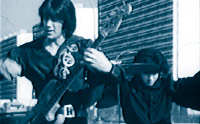 Roundabout
finally had a viable line up: Ritchie Blackmore, Rod Evans, Jon Lord,
Ian Paice and Nick Simper. Now all they had to do was sort out the music
and the live act. Roundabout
finally had a viable line up: Ritchie Blackmore, Rod Evans, Jon Lord,
Ian Paice and Nick Simper. Now all they had to do was sort out the music
and the live act.
"We cobbled this stage act together," says Simper. "We weren't sure
how people would react. It had to be visually exciting, Ritchie and
I used to practise our gyrations in front of mirrors."
"There was an element of show in the way we put the band together."
admits Lord. "When we first started playing live I was astonished at
Ritchie's antics. He was marvellous, very balletic. Ritchie was very
much a showman. He'd come out of the mid-'60s thing, the guitar behind
the head, like Joe Brown."
"The idea was that we would look good, we weren't going to be like a
California hippy band," continues Lord. "We were going to play loud
and hard and dress cool. We were dressed quite early on with Tony Edwards'
money, at [boutique] Mr Fish. Their clothes looked great for a good
40 minutes, but then they fell off you. I wanted to look like John Lennon
without the glasses. For a while we looked incredibly cool - we thought.
A lot of people thought we looked like prats."
"The sound
was very confusing," says Ian Paice. "It was down to Jon and Ritchie
as to how the band would move forward. The playing was very good, but
the band had no idea what it wanted to be. The influence of Vanilla
Fudge was to make music that was a little more interesting. That's why
the first record had all those long arrangements."
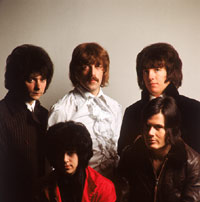 Paying
close attention to the rehearsals was Derek Lawrence, an independent
producer who Blackmore knew from his days with Joe Meek. Lawrence took
the band into the studio in late March 1968 to record some demos, amongst
which was a cover of Billy Joe Royal's Hush. "Nick Simper and I came
up with Hush," recalls Lord. "It was very big in the clubs at that time,
The Cromwellian, Blazes." Paying
close attention to the rehearsals was Derek Lawrence, an independent
producer who Blackmore knew from his days with Joe Meek. Lawrence took
the band into the studio in late March 1968 to record some demos, amongst
which was a cover of Billy Joe Royal's Hush. "Nick Simper and I came
up with Hush," recalls Lord. "It was very big in the clubs at that time,
The Cromwellian, Blazes."
Simper says it was he and Blackmore came up with the song: "The version
Ritchie and I heard was by Kris Ife, in Manchester at a discotheque
called the Phonograph. I had a friend in a ballroom band who taught
us the song. We created our own version without ever really hearing
the record."
Back then, the band had agreed the name Roundabout had to go. "We had
a list [of band names] on the wall at Deeves Hall," says Lord. "It was
very nearly Orpheus. Concrete God we thought was a bit radical. Sugarlump
was on there. One morning Deep Purple was on it. After intense interrogation
it turned out that Ritchie had put it up. The reason was that it was
his grandmother's favourite song."
Blackmore
didn't let anyone know if he was thinking of Nino Tempo and April Steven's
1963 hit cover of Deep Purple, or an earlier version of the 1920's standard.
The quintet got their first chance to play before an audience in April
1968 during a short string of dates in Denmark - familiar territory
for Lord, who had made some impact there the previous year with the
St Valentine's Day Massacre version of The Artwoods. The major advantage
of playing Denmark was that it was out of the spotlight.
Lord: "The rather cynical view was that if we went over and made a balls
up, it would be the waste of a good name. So we went over as Roundabout.
If it didn't work we could still keep the name Deep Purple."
Nick Simper has a slightly different memory: "Right up to being on the
boat to Denmark we didn't have a name. Of course Tony Edwards said Roundabout.
On the boat this reporter came over - it was obvious we were a group
with the dyed black hair - and asked us what out name was. Ritchie said
Deep Purple."
But as far as the Danish public were concerned, they weren't seeing
a band called Deep Purple. "The first show was billed as Roundabout,
but the poster also said Flowerpot Men and Artwoods," says Simper. The
dates themselves were a coup. "We were trying to outdo each other, leap
about," continues Simper. "It was an outrageous success."
For Ian Paice, however, it was the band's arrival in Denmark which left
a lasting impression: "We took the boat from Harwich to Esbjerg. You
needed a work permit and ours wasn't quite in order. I was taken from
the docks to the police station in the back of a police-dog van, behind
the wire grill. Which was a very auspicious start. When I got out, I
was smelling somewhat canine."

Roundabout became Deep Purple and Hush became their first single, released
by EMI's Parlophone label in June 1968. It was a stunning debut: driving
and hard, funky and melodic. Although Hush didn't trouble the British
charts, it reached number 4 in the American national Top 40.
Lord: "Hush was huge in California. We didn't know that there was a
very strong, intense type of acid going around California call Deep
Purple. Pure coincidence. When we first got the States people we going
'cool band, cool name.' I'm sure it had a lot to do with that first
success."
Deep Purple spent much of the next year in America. They had landed
on a US label that was prepared to promote the band - hard. Via their
producer Derek Lawrence, Deep Purple had signed with a new American
label called Tetragrammaton, funded by comedian Bill Cosby. Tetragrammaton
"were very showbizzy," says Lord. "Bill Cosby had all these showbiz
pals, including Hugh Hefner. On our second night in America we were
invited to a party at the penthouse suite of the Playboy Club. During
that evening Hefner said 'do you want to be on my TV show? Your guitarist
could pretend to teach me how to play guitar.'"
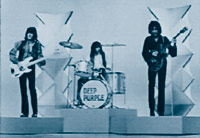 Another
early promotional stunt was even sillier. "We also appeared on The Dating
Game," continues Lord. "There had never before been a rock band
on the show. One of us had to play the game and I didn't step back quickly
enough. Deep Purple didn't mean a great deal to the rather preppy girl.
One boy was a college guy from Encino, then there was Jon, a musician
from England. One question was, 'if you came round to pick me up and
my father appeared at the door and said, get your hair cut. Would you
do it for me?' I said 'absolutely not, if he and you couldn't like me
for what I am, then I don't belong there.' I was pissed off I wasn't
chosen, she was very beautiful." Another
early promotional stunt was even sillier. "We also appeared on The Dating
Game," continues Lord. "There had never before been a rock band
on the show. One of us had to play the game and I didn't step back quickly
enough. Deep Purple didn't mean a great deal to the rather preppy girl.
One boy was a college guy from Encino, then there was Jon, a musician
from England. One question was, 'if you came round to pick me up and
my father appeared at the door and said, get your hair cut. Would you
do it for me?' I said 'absolutely not, if he and you couldn't like me
for what I am, then I don't belong there.' I was pissed off I wasn't
chosen, she was very beautiful."
Back in the UK, EMI didn't seem interested in Deep Purple. Their first
album, Shades Of Deep Purple was issued in America in July 1968. In
Britain, it was released in September 1968. The disinterest was underlined
after the release of The Book Of Taliesyn, the band's second album.
Issued Stateside in October 1968, it hit the UK's shops in July 1969.
"We were big business in America," says Simper. "EMI did nothing, they
were stupid old guys."
Ian Paice is more sanguine about the early American success: "It was
the biggest market in the world. If you have America without the rest
of the world, you can exist quite nicely. But if you don't have America,
it's not that easy."
Deep
Purple spent the last three months of 1968 in the States, playing huge
venues like Los Angeles' Inglewood Forum (with Cream) and returned to
the UK in the New Year to find themselves booked at the likes of Goldsmith's
College student's union in south London. It just wasn't the same. Relations
in the band weren't quite the same either. "Once we started making money
the friendship went out the window," recalls Simper. "Ritchie was particularly
incensed because Rod Evans and Jon Lord had got the B-side to Hush and
got a few bucks coming in. Ritchie said 'all Rod Evans does is write
bloody words.' I said, 'well any idiot can write a guitar riff, you
try and write some meaningful lyrics.' He wasn't very pleased."
March, April and May 1969 were spent touring the US. Before returning
to America Deep Purple had recorded their third album 'Deep Purple'.
As usual, it was released at home months after America. More importantly,
by the time the album was issued in the UK, it was out of date in more
ways than one. A new Deep Purple had already been created. Rod Evans
and Nick Simper were touring America with no idea that their days in
Deep Purple were numbered. Ritchie Blackmore, Jon Lord and Ian Paice
were secretly plotting their demise.

 Ian
Paice: "The three of us had a discussion in New York [in late May 1969].
We thought that Rod and Nick had gone about as far as they could. Rod
had great ballad voice, but the limitations of that were becoming obvious.
Nick was a fine bass player, but his loves were in the past not in the
future. We decided that if it was going to be a break, it was going
to be a substantial one to refocus the band to look forward, to break
this feeling of stagnation." Ian
Paice: "The three of us had a discussion in New York [in late May 1969].
We thought that Rod and Nick had gone about as far as they could. Rod
had great ballad voice, but the limitations of that were becoming obvious.
Nick was a fine bass player, but his loves were in the past not in the
future. We decided that if it was going to be a break, it was going
to be a substantial one to refocus the band to look forward, to break
this feeling of stagnation."
Jon Lord: "Ritchie, Ian and I had come to the conclusion that Rod couldn't
take us to where we want to go. We wanted to become harder, to write
our own material. Rod was a bit of a cabaret singer. We needed a lyricist.
It was a very cold decision. Rod was a really nice guy and didn't deserve
to be treated in such a cavalier fashion."
Surprisingly, Nick Simper agrees that Rod Evans only had himself to
blame: "Rod was losing interest, he was about to marry a lady whose
parents were really wealthy. He had got the Hollywood bug and wanted
to become an actor. Rock 'n' roll had become small fry to him. His stage
performance was going down and down."
A week after returning from America, in early June, Deep Purple were
set to record their next single, Hallelujah. Simper had heard rumours
that he was being dumped: "I had been told, but rubbished it and said
there's always rumours."
He didn't know that the search for a new singer was already on and would
(as a by-product) provide Deep Purple with its new bass player.
"Ritchie had started looking around clubs and pubs," recalls Ian Paice.
"He went to see Episode Six and was blown away with this shattering
voice of Ian Gillan's"
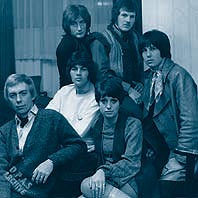 Episode
Six were a pop group making a living slogging around the ballroom and
club circuit, but had made no impact on record buyers. Episode
Six were a pop group making a living slogging around the ballroom and
club circuit, but had made no impact on record buyers.
Their bass player, Roger Glover, recalls his first contact with Deep
Purple: "Mick Underwood, our drummer in Episode Six, got a call from
Ritchie Blackmore. The upshot was they were looking for a singer. Bass
player wasn't mentioned. Jon Lord and Ritchie Blackmore came to a youth
club in Woodford. I certainly hadn't heard of Deep Purple, the first
I knew of them was when Ian Gillan told me they had a hit in the States.
I didn't meet them that night, but I thought they were very nefarious
characters. Ritchie got up and had a jam, a blues. I was quite impressed,
but my overriding impression was they all wore black. They looked mysterious.
They had dyed black hair, and lots of it."
Ian Gillan accepted the invitation to join Deep Purple and invited Glover
to meet Jon Lord, who was looking for songs. "Ian had become my songwriting
partner," explains Glover. "I went along to meet Jon Lord. In person
he wasn't anything like I imagined. He was such a nice man. I was blown
away with his geniality. We nervously played our songs, about monkeys
and lions - monkeys always appeared in our lyrics those days. But there
was nothing that interested him. He played a demo of Hallelujah and
said 'what do you think of that? Do you think it's a hit?"
As a result Glover was invited to the recording session for Hallelujah,
an off-the-shelf song composed by Tin Pan Alley writers Cook and Greenaway.
Nick Simper still had no idea that his replacement was playing with
Deep Purple. Roger Glover, however, realised that he was about to join
something big.
"I walked into the studio, early evening. The thing that impressed me
most was their clothes. They all had new clothes. I didn't buy clothes,
I used hand me downs. I used to make my own stage gear. I had no socks
on, the bottoms of my jeans were frayed, they were held up by string.
There were a couple of Marshall stacks, a Precision bass, it all looked
very new. At the end of the session Jon came up and said 'would you
like to join our band?' I was floored."
Nick Simper and Rod Evans, however, remained ignorant about their fate.
"Nobody told me," says Simper. "I found out by deduction [about being
replaced]. I told Rod Evans. Rod Evans had bent over backwards to get
Ian Paice in and was gutted by the lack of support."
"It was pretty difficult [breaking with fellow ex-Maze member Evans],"
says Paice. "But it was nowhere near as difficult as leaving my first
semi-pro band, because then I knew it was the end of the band. When
it's your business, you are looking after yourself."
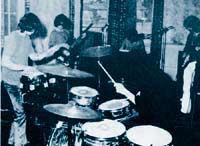 If
it seems amazing that Deep Purple could record a single without telling
the singer and bass player that they had already been replaced, consider
this as an insight into the band's people-management skills. After
recording the - flop - Hallelujah single, Deep Purple were secretly
rehearsing by day at west London's Hanwell Community centre with Gillan
and Glover, and playing shows in the evening with the still-in-the-dark
Evans and Simper. "It was normal behaviour for Purple," says Glover.
"I became aware that the modus operandi for Deep Purple was if there
is a problem don't talk about it. Management is what you rely on to
sort things out, musicians tend to shed their responsibilities as human
beings once they're in a band. You have this cotton-wool surrounding
you. I felt very bad about Nicky and Rod and felt they should have been
told." If
it seems amazing that Deep Purple could record a single without telling
the singer and bass player that they had already been replaced, consider
this as an insight into the band's people-management skills. After
recording the - flop - Hallelujah single, Deep Purple were secretly
rehearsing by day at west London's Hanwell Community centre with Gillan
and Glover, and playing shows in the evening with the still-in-the-dark
Evans and Simper. "It was normal behaviour for Purple," says Glover.
"I became aware that the modus operandi for Deep Purple was if there
is a problem don't talk about it. Management is what you rely on to
sort things out, musicians tend to shed their responsibilities as human
beings once they're in a band. You have this cotton-wool surrounding
you. I felt very bad about Nicky and Rod and felt they should have been
told."

Ian
Gillan and Roger Glover had joined a band that was running out of steam
in the US and had little identity in the UK. Post-Hush singles had fared
less and less well in the American charts. Before Evans and Simper had
been given the boot, Jon Lord had put an idea to the band's management
that was very attractive, particularly as it had some potential for
increasing Deep Purple's media profile.
"Jon Lord said to me at the end of an American tour, that he'd always
dreamed of writing a work that could be performed by a rock group and
a symphony orchestra," recalls Tony Edwards. "I just said 'how long
would it take?' I came home, booked the Albert Hall and he was appalled.
Once he'd got over the shock, he thought it was wonderful. And it came
to pass." It
was to become the Concerto for Group and Orchestra.
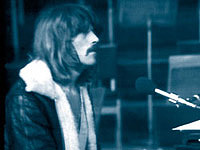 "I'd had the idea when I was in The Artwoods," explains Lord. "Based
on an album I'd heard by Dave Brubeck, called Brubeck Plays Bernstein
Plays Brubeck. When Purple began gathering steam I realised I was in
the right band to do it. Ritchie was all for it. Just after Ian and
Roger joined, Tony said 'were you serious about that? I've booked the
Royal Albert Hall and the London Philharmonic Orchestra for September
24th' So I had about three months to write it, and I did. I'd get back
from a gig and go to work."
"I'd had the idea when I was in The Artwoods," explains Lord. "Based
on an album I'd heard by Dave Brubeck, called Brubeck Plays Bernstein
Plays Brubeck. When Purple began gathering steam I realised I was in
the right band to do it. Ritchie was all for it. Just after Ian and
Roger joined, Tony said 'were you serious about that? I've booked the
Royal Albert Hall and the London Philharmonic Orchestra for September
24th' So I had about three months to write it, and I did. I'd get back
from a gig and go to work."
Deep Purple's publishers engaged Oscar-winning composer Malcolm Arnold
to oversee the creation of the concerto and conduct the orchestra.
"I didn't know, but had Malcolm said it was crap it would have been
dead in the water," continues Lord. "I had it written up to about two
minutes in. He said 'this is jolly good, this will work fine.' I had
never met a more open, giving musician. I'd send him a few pages, get
a letter back saying 'fabulous stuff , keep going lad.' I could not
have done it without him."
The band's management found sponsorship from The Daily Express and British
Lion Films, who filmed the event. Ian Gillan and Roger Glover had been
in Deep Purple for only three months and were expected to play at London's
most prestigious concert venue with an orchestra.
"Jon was very kind," says Glover. "None of us read music, so our manuscripts
consisted of 'wait for the silly tune, watch Malcolm and count to four.'
It was an awe-inspiring event. I'd never so many musicians in one room
before. But by this time I was getting used to being surprised. Not
only had this band been to America, they slept in king-size beds and
had air conditioning. It was a whole new world."
"The possibilities to get our name in all the big papers was very enticing,"
says Paice. "I was glad I did it, but it's not what I am. When you're
a kid, as I was then, you're bullet proof, you think you can do anything.
What have you got to lose? Stop and start music is not what a drummer
enjoys. But it tended to confuse a lot of people."
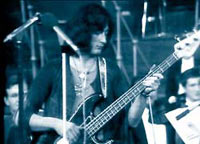 The
Concerto achieved what it set out to do and, when released, became Deep
Purple's first UK chart album. But, as Ian Paice says, it confused both
the audience and the focus within the band. The
Concerto achieved what it set out to do and, when released, became Deep
Purple's first UK chart album. But, as Ian Paice says, it confused both
the audience and the focus within the band.
"We realised there some confusion about our identity," says Glover.
"The aftermath of the Concerto was we got tons of publicity, but in
the band it didn't go down very well. Jon was getting all the plaudits
for being the leader and this went right up Ritchie's nose. Ian Gillan
felt pretty much the same. The split between the musical side of Jon
and the harder side of Ritchie came to a head when we started doing
gigs after the Concerto. Promoters would go 'where's the orchestra'.
There was one gig where the promoter said 'I can't get an orchestra,
but I can get a brass band.'"
"The Concerto was a dream, but it didn't mean I wanted the band to be
prog rock," explains Lord. "I fully recognised the massive opportunity
we were given when Gillan and Glover joined, to realise this harder-edged,
more crazy music." That
opportunity was fully realised in late 1969 when Deep Purple began recording
the classic In Rock album.
"We were in the studio and Ritchie said 'if it's not exciting or dramatic
it doesn't belong on this album'," recalls Glover. "That became a byword
for what we were doing."

When the band's management decided there was no single on the album,
Deep Purple were frog-marched back into the studio to record one. Black
Night was the result, and became Deep Purple's first UK chart single
and calling card for their future world-wide success. In time, album
tracks like In Rock's Child In Time became as familiar as any hit single,
blaring out of the bedrooms of teenage boys everywhere. In Rock began
a new cycle for Deep Purple. Between its release in June 1970 and Gillan
and Glover's departure in June 1973, they released three albums, never
stopped working, toured constantly and became the Deep Purple familiar
to millions.
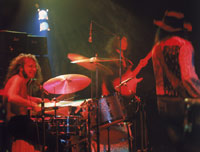 The
touring might have almost killed the band off, but any signs of problems-to-come
weren't immediately apparent. "We weren't aware of the pressure," says
Roger Glover. "We were on tour forever and it became a routine, and
routine kills. But we dwell on the negative, because that's what people
want to hear. By and large Deep Purple was a happy experience." The
touring might have almost killed the band off, but any signs of problems-to-come
weren't immediately apparent. "We weren't aware of the pressure," says
Roger Glover. "We were on tour forever and it became a routine, and
routine kills. But we dwell on the negative, because that's what people
want to hear. By and large Deep Purple was a happy experience."
"I enjoyed being on the road every day," says Ian Paice. "It never affected
me. I've been lucky that way. I was incredibly fit in my youth. The
physical demands were never a problem, life was a party. I was a kid
on the road with a big rock 'n' roll band, once I'd finished work I
was looking for the next party, the next gorgeous-looking woman. I never
wanted it to stop."
It didn't stop for Ian Paice and Jon Lord until July 1976 - when Deep
Purple split they were the only survivors from the early days. The name
Deep Purple was always more than the sum of its parts.
Ritchie Blackmore and Ian Gillan declined the invitation to be interviewed
for this article. Thanks to Samantha Gallop at EMI, Joni Hollar, Simon
Robinson of The Deep Purple Appreciation Society (www.deep-purple.net)
Mark Stratford and everyone who gave the time to be interviewed. Rod
Evans: if you're out there, get in touch.
copyright,
Kieron Tyler

dpas
note : Kieron Tyler's article was published in Mojo Magazine, Jan 2003
issue. The magazine's editors decided they wanted more on the subsequent
history of the band and less on the formation. Kieron thus offered deep-purple.net
his original draft.
|

 In
1966 Edwards was working in London's West End for Alice Edwards Holdings
Ltd, his family's clothing company. He'd turned his hand to the pop
scene after coming across a singer-turned-model named Ayshea (later
familiar to pop fans from compering the '70s tea-time pop show Lift
Off).
In
1966 Edwards was working in London's West End for Alice Edwards Holdings
Ltd, his family's clothing company. He'd turned his hand to the pop
scene after coming across a singer-turned-model named Ayshea (later
familiar to pop fans from compering the '70s tea-time pop show Lift
Off). Lord
first encountered Curtis at a party hosted by the ubiquitous Vicki Wickham:
Lord
first encountered Curtis at a party hosted by the ubiquitous Vicki Wickham: Unbeknownst
to Lord, Edwards had already sneaked Blackmore into the UK to check
out a Flowerpot Men gig. Edwards recalls Blackmore as "dark, saturnine,
brooding, with a great charisma. I can't remember him saying much. He
looked around. Searchingly. But Chris disappeared back to Liverpool.
Blackmore went back to Germany. The whole concept fell into disarray."
That really
should have been it for Roundabout. Chris Curtis may have vanished and
Ritchie Blackmore had returned to Germany, but Tony Edwards had been
bitten by the pop bug.
Unbeknownst
to Lord, Edwards had already sneaked Blackmore into the UK to check
out a Flowerpot Men gig. Edwards recalls Blackmore as "dark, saturnine,
brooding, with a great charisma. I can't remember him saying much. He
looked around. Searchingly. But Chris disappeared back to Liverpool.
Blackmore went back to Germany. The whole concept fell into disarray."
That really
should have been it for Roundabout. Chris Curtis may have vanished and
Ritchie Blackmore had returned to Germany, but Tony Edwards had been
bitten by the pop bug. Edwards
decided that he was in all the way and began committing himself to the
nascent band, still named Roundabout. "I financed the concept.
All my personal shareholdings in the family business were there as collateral
for
Edwards
decided that he was in all the way and began committing himself to the
nascent band, still named Roundabout. "I financed the concept.
All my personal shareholdings in the family business were there as collateral
for "Occasionally
Tony Edwards would come down to see what he had wrought and he would
walk away looking very puzzled," says Lord. "Vanilla Fudge
were very much an influence. They'd appeared at The Speakeasy, and had
amazed me. I had a long chat with [Fudge vocalist and organist] Mark
Stein that night. I learnt a couple of tricks that I put to use."
"Occasionally
Tony Edwards would come down to see what he had wrought and he would
walk away looking very puzzled," says Lord. "Vanilla Fudge
were very much an influence. They'd appeared at The Speakeasy, and had
amazed me. I had a long chat with [Fudge vocalist and organist] Mark
Stein that night. I learnt a couple of tricks that I put to use." A
double-handed solution to the singer/drummer issue turned up in the
form of Rod Evans and Ian Paice, singer and drummer in a band called
The Maze. When Rod Evans arranged to audition for Roundabout, he was
asked to bring his band's drummer along.
A
double-handed solution to the singer/drummer issue turned up in the
form of Rod Evans and Ian Paice, singer and drummer in a band called
The Maze. When Rod Evans arranged to audition for Roundabout, he was
asked to bring his band's drummer along. Roundabout
finally had a viable line up: Ritchie Blackmore, Rod Evans, Jon Lord,
Ian Paice and Nick Simper. Now all they had to do was sort out the music
and the live act.
Roundabout
finally had a viable line up: Ritchie Blackmore, Rod Evans, Jon Lord,
Ian Paice and Nick Simper. Now all they had to do was sort out the music
and the live act. Paying
close attention to the rehearsals was Derek Lawrence, an independent
producer who Blackmore knew from his days with Joe Meek. Lawrence took
the band into the studio in late March 1968 to record some demos, amongst
which was a cover of Billy Joe Royal's Hush. "Nick Simper and I came
up with Hush," recalls Lord. "It was very big in the clubs at that time,
The Cromwellian, Blazes."
Paying
close attention to the rehearsals was Derek Lawrence, an independent
producer who Blackmore knew from his days with Joe Meek. Lawrence took
the band into the studio in late March 1968 to record some demos, amongst
which was a cover of Billy Joe Royal's Hush. "Nick Simper and I came
up with Hush," recalls Lord. "It was very big in the clubs at that time,
The Cromwellian, Blazes." Another
early promotional stunt was even sillier. "We also appeared on The Dating
Game," continues Lord. "There had never before been a rock band
on the show. One of us had to play the game and I didn't step back quickly
enough. Deep Purple didn't mean a great deal to the rather preppy girl.
One boy was a college guy from Encino, then there was Jon, a musician
from England. One question was, 'if you came round to pick me up and
my father appeared at the door and said, get your hair cut. Would you
do it for me?' I said 'absolutely not, if he and you couldn't like me
for what I am, then I don't belong there.' I was pissed off I wasn't
chosen, she was very beautiful."
Another
early promotional stunt was even sillier. "We also appeared on The Dating
Game," continues Lord. "There had never before been a rock band
on the show. One of us had to play the game and I didn't step back quickly
enough. Deep Purple didn't mean a great deal to the rather preppy girl.
One boy was a college guy from Encino, then there was Jon, a musician
from England. One question was, 'if you came round to pick me up and
my father appeared at the door and said, get your hair cut. Would you
do it for me?' I said 'absolutely not, if he and you couldn't like me
for what I am, then I don't belong there.' I was pissed off I wasn't
chosen, she was very beautiful." Ian
Paice: "The three of us had a discussion in New York [in late May 1969].
We thought that Rod and Nick had gone about as far as they could. Rod
had great ballad voice, but the limitations of that were becoming obvious.
Nick was a fine bass player, but his loves were in the past not in the
future. We decided that if it was going to be a break, it was going
to be a substantial one to refocus the band to look forward, to break
this feeling of stagnation."
Ian
Paice: "The three of us had a discussion in New York [in late May 1969].
We thought that Rod and Nick had gone about as far as they could. Rod
had great ballad voice, but the limitations of that were becoming obvious.
Nick was a fine bass player, but his loves were in the past not in the
future. We decided that if it was going to be a break, it was going
to be a substantial one to refocus the band to look forward, to break
this feeling of stagnation." Episode
Six were a pop group making a living slogging around the ballroom and
club circuit, but had made no impact on record buyers.
Episode
Six were a pop group making a living slogging around the ballroom and
club circuit, but had made no impact on record buyers. If
it seems amazing that Deep Purple could record a single without telling
the singer and bass player that they had already been replaced, consider
this as an insight into the band's people-management skills. After
recording the - flop - Hallelujah single, Deep Purple were secretly
rehearsing by day at west London's Hanwell Community centre with Gillan
and Glover, and playing shows in the evening with the still-in-the-dark
Evans and Simper. "It was normal behaviour for Purple," says Glover.
"I became aware that the modus operandi for Deep Purple was if there
is a problem don't talk about it. Management is what you rely on to
sort things out, musicians tend to shed their responsibilities as human
beings once they're in a band. You have this cotton-wool surrounding
you. I felt very bad about Nicky and Rod and felt they should have been
told."
If
it seems amazing that Deep Purple could record a single without telling
the singer and bass player that they had already been replaced, consider
this as an insight into the band's people-management skills. After
recording the - flop - Hallelujah single, Deep Purple were secretly
rehearsing by day at west London's Hanwell Community centre with Gillan
and Glover, and playing shows in the evening with the still-in-the-dark
Evans and Simper. "It was normal behaviour for Purple," says Glover.
"I became aware that the modus operandi for Deep Purple was if there
is a problem don't talk about it. Management is what you rely on to
sort things out, musicians tend to shed their responsibilities as human
beings once they're in a band. You have this cotton-wool surrounding
you. I felt very bad about Nicky and Rod and felt they should have been
told." "I'd had the idea when I was in The Artwoods," explains Lord. "Based
on an album I'd heard by Dave Brubeck, called Brubeck Plays Bernstein
Plays Brubeck. When Purple began gathering steam I realised I was in
the right band to do it. Ritchie was all for it. Just after Ian and
Roger joined, Tony said 'were you serious about that? I've booked the
Royal Albert Hall and the London Philharmonic Orchestra for September
24th' So I had about three months to write it, and I did. I'd get back
from a gig and go to work."
"I'd had the idea when I was in The Artwoods," explains Lord. "Based
on an album I'd heard by Dave Brubeck, called Brubeck Plays Bernstein
Plays Brubeck. When Purple began gathering steam I realised I was in
the right band to do it. Ritchie was all for it. Just after Ian and
Roger joined, Tony said 'were you serious about that? I've booked the
Royal Albert Hall and the London Philharmonic Orchestra for September
24th' So I had about three months to write it, and I did. I'd get back
from a gig and go to work." The
Concerto achieved what it set out to do and, when released, became Deep
Purple's first UK chart album. But, as Ian Paice says, it confused both
the audience and the focus within the band.
The
Concerto achieved what it set out to do and, when released, became Deep
Purple's first UK chart album. But, as Ian Paice says, it confused both
the audience and the focus within the band. The
touring might have almost killed the band off, but any signs of problems-to-come
weren't immediately apparent. "We weren't aware of the pressure," says
Roger Glover. "We were on tour forever and it became a routine, and
routine kills. But we dwell on the negative, because that's what people
want to hear. By and large Deep Purple was a happy experience."
The
touring might have almost killed the band off, but any signs of problems-to-come
weren't immediately apparent. "We weren't aware of the pressure," says
Roger Glover. "We were on tour forever and it became a routine, and
routine kills. But we dwell on the negative, because that's what people
want to hear. By and large Deep Purple was a happy experience."